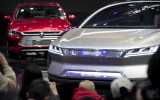


Some of Australia’s best-selling electric vehicles fail to meet their advertised range and consume significantly more power than manufacturers promise, on-road tests reveal.
One popular SUV performed particularly poorly, stopping short of its advertised range by more than 100 kilometres, which one motoring group called “not good enough”.
The Australian Automobile Association released the results on Thursday after testing five electric vehicles as part of its $14 million Real-World Testing Program.
The motoring body road-tested five electric vehicles in its first trial of the technology, using a 93-kilometre circuit around Geelong in Victoria in damp and dry conditions, and measuring the vehicles’ energy consumption.
BYD’s Atto 3 SUV had the worst result of the models tested, falling short of its promised range by 111 kilometres, or 23 per cent, and using 21 per cent more power than advertised.
Tesla’s entry-level electric car, the Model 3, also failed to meet its promised range by 14 per cent, or 72 kilometres, and used 6 per cent more electricity than lab results showed.
The Tesla Model Y and Kia EV6 SUVs also failed to meet their range by 8 per cent, or just over 40 kilometres, while the Smart #3 electric car came the closest to its lab test results, falling within 5 per cent or 23 kilometres of the advertised range.
Significant differences between the advertised and actual range or fuel consumption of vehicles had the potential to mislead buyers, NRMA spokesman Peter Khoury said, and were not acceptable.
“A gap of 23 per cent or 26 per cent is obviously not good enough,” he said.
“It is important that people are getting what they’re paying for.”
The results underlined the importance of independently testing vehicles, Khoury said, as laboratory test results had proven unreliable for both fuel and electric cars.
The findings come a week after the program revealed 25 out of 30 petrol and hybrid vehicles tested had consumed more fuel than their lab results showed and more than three in every four vehicles examined in the scheme failed to meet expectations.
An electric car’s range could be affected by multiple factors, Australian Electric Vehicle Association national president Chris Jones said.
These included high or low temperatures, headwinds, steep terrain, and use of air-conditioning and heating features.
Car makers should seek to “underpromise and overdeliver” when it comes to vehicle range, he said, to allow buyers to make informed choices about models that would suit their needs.
“It is frustrating that manufacturers are inflating the values when they really ought to be a bit more conservative,” Jones said.
“I would have thought a 10 per cent difference was reasonable but 20 per cent is pretty bad.”
Electric vehicle range is typically tested in Australia using the older New European Driving Cycle laboratory test. This will be replaced by the more accurate Worldwide Harmonised Light Vehicle Test Procedure from December.
The Australian Automobile Association’s vehicle-testing program, funded by the federal government, has examined 114 fuel-powered vehicles since it began in 2023 and found 88 models, or 77 per cent, failed to meet their advertised energy consumption.
-AAP










